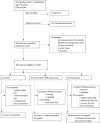Effect of the Tool to Reduce Inappropriate Medications on Medication Communication and Deprescribing - PubMed (original) (raw)
Randomized Controlled Trial
. 2017 Oct;65(10):2265-2271.
doi: 10.1111/jgs.15042. Epub 2017 Aug 14.
Affiliations
- PMID: 28804870
- PMCID: PMC5641237
- DOI: 10.1111/jgs.15042
Randomized Controlled Trial
Effect of the Tool to Reduce Inappropriate Medications on Medication Communication and Deprescribing
Terri R Fried et al. J Am Geriatr Soc. 2017 Oct.
Abstract
Objectives: To examine the effect of the Tool to Reduce Inappropriate Medications (TRIM), a web tool linking an electronic health record (EHR) to a clinical decision support system, on medication communication and prescribing.
Design: Randomized clinical trial.
Setting: Primary care clinics at a Veterans Affairs Medical Center.
Participants: Veterans aged 65 and older prescribed seven or more medications randomized to receipt of TRIM or usual care (N = 128).
Intervention: TRIM extracts information on medications and chronic conditions from the EHR and contains data entry screens for information obtained from brief chart review and telephonic patient assessment. These data serve as input for automated algorithms identifying medication reconciliation discrepancies, potentially inappropriate medications (PIMs), and potentially inappropriate regimens. Clinician feedback reports summarize discrepancies and provide recommendations for deprescribing. Patient feedback reports summarize discrepancies and self-reported medication problems.
Measurements: Primary: subscales of the Patient Assessment of Care for Chronic Conditions (PACIC) related to shared decision-making; clinician and patient communication. Secondary: changes in medications.
Results: 29.7% of TRIM participants and 15.6% of control participants provided the highest PACIC ratings; this difference was not significant. Adjusting for covariates and clustering of patients within clinicians, TRIM was associated with significantly more-active patient communication and facilitative clinician communication and with more medication-related communication among patients and clinicians. TRIM was significantly associated with correction of medication discrepancies but had no effect on number of medications or reduction in PIMs.
Conclusion: TRIM improved communication about medications and accuracy of documentation. Although there was no association with prescribing, the small sample size provided limited power to examine medication-related outcomes.
Keywords: communication; medication prescribing; polypharmacy.
© 2017, Copyright the Authors Journal compilation © 2017, The American Geriatrics Society.
Conflict of interest statement
Conflict of interest:
The authors have no conflicts of interest to disclose.
Figures
Figure 1
Flow diagram for study
Similar articles
- Development of the Tool to Reduce Inappropriate Medications (TRIM): A Clinical Decision Support System to Improve Medication Prescribing for Older Adults.
Niehoff KM, Rajeevan N, Charpentier PA, Miller PL, Goldstein MK, Fried TR. Niehoff KM, et al. Pharmacotherapy. 2016 Jun;36(6):694-701. doi: 10.1002/phar.1751. Epub 2016 May 28. Pharmacotherapy. 2016. PMID: 27041466 Free PMC article. - The MedSafer Study: A Controlled Trial of an Electronic Decision Support Tool for Deprescribing in Acute Care.
McDonald EG, Wu PE, Rashidi B, Forster AJ, Huang A, Pilote L, Papillon-Ferland L, Bonnici A, Tamblyn R, Whitty R, Porter S, Battu K, Downar J, Lee TC. McDonald EG, et al. J Am Geriatr Soc. 2019 Sep;67(9):1843-1850. doi: 10.1111/jgs.16040. Epub 2019 Jun 27. J Am Geriatr Soc. 2019. PMID: 31250427 Clinical Trial. - Primary care clinicians' use of deprescribing recommendations: A mixed-methods study.
Mecca MC, Zenoni M, Fried TR. Mecca MC, et al. Patient Educ Couns. 2022 Aug;105(8):2715-2720. doi: 10.1016/j.pec.2022.04.013. Epub 2022 Apr 22. Patient Educ Couns. 2022. PMID: 35523638 - Thoughtful Prescribing and Deprescribing.
Pravodelov V. Pravodelov V. Med Clin North Am. 2020 Sep;104(5):751-765. doi: 10.1016/j.mcna.2020.06.001. Med Clin North Am. 2020. PMID: 32773043 Review. - Deprescribing for Community-Dwelling Older Adults: a Systematic Review and Meta-analysis.
Bloomfield HE, Greer N, Linsky AM, Bolduc J, Naidl T, Vardeny O, MacDonald R, McKenzie L, Wilt TJ. Bloomfield HE, et al. J Gen Intern Med. 2020 Nov;35(11):3323-3332. doi: 10.1007/s11606-020-06089-2. Epub 2020 Aug 20. J Gen Intern Med. 2020. PMID: 32820421 Free PMC article. Review.
Cited by
- Deprescribing medicines in older people living with multimorbidity and polypharmacy: the TAILOR evidence synthesis.
Reeve J, Maden M, Hill R, Turk A, Mahtani K, Wong G, Lasserson D, Krska J, Mangin D, Byng R, Wallace E, Ranson E. Reeve J, et al. Health Technol Assess. 2022 Jul;26(32):1-148. doi: 10.3310/AAFO2475. Health Technol Assess. 2022. PMID: 35894932 Free PMC article. Review. - A pharmacist-physician intervention model using a computerized alert system to reduce high-risk medication use in primary care.
Cossette B, Taseen R, Roy-Petit J, Villemure MP, Grondin M, Ricard G, Goyer F, Blanchard C, Joly-Mischlich T, Éthier JF. Cossette B, et al. Eur J Clin Pharmacol. 2019 Jul;75(7):1017-1023. doi: 10.1007/s00228-019-02660-x. Epub 2019 Mar 21. Eur J Clin Pharmacol. 2019. PMID: 30899989 - Principle of rational prescribing and deprescribing in older adults with multiple chronic conditions.
Ouellet GM, Ouellet JA, Tinetti ME. Ouellet GM, et al. Ther Adv Drug Saf. 2018 Aug 9;9(11):639-652. doi: 10.1177/2042098618791371. eCollection 2018 Nov. Ther Adv Drug Saf. 2018. PMID: 30479739 Free PMC article. Review. - Deprescribing one year on: challenging the first iatrogenic epidemic.
Barnett N, Garfinkel D. Barnett N, et al. Eur J Hosp Pharm. 2018 Mar;25(2):63-64. doi: 10.1136/ejhpharm-2017-001482. Epub 2018 Jan 27. Eur J Hosp Pharm. 2018. PMID: 31156989 Free PMC article. No abstract available. - Using EMR-enabled computerized decision support systems to reduce prescribing of potentially inappropriate medications: a narrative review.
Scott IA, Pillans PI, Barras M, Morris C. Scott IA, et al. Ther Adv Drug Saf. 2018 Jul 12;9(9):559-573. doi: 10.1177/2042098618784809. eCollection 2018 Sep. Ther Adv Drug Saf. 2018. PMID: 30181862 Free PMC article. Review.
References
- Medicare Payment Advisory Commission (US) Report to the Congress: Medicare and the Health Care Delivery System. Medicare Payment Advisory Commission; 2015.
- Steinman MA, Seth Landefeld C, Rosenthal GE, et al. Polypharmacy and prescribing quality in older people. J Am Geriatr Soc. 2006;54:1516–23. - PubMed
Publication types
MeSH terms
LinkOut - more resources
Full Text Sources
Other Literature Sources
Medical
